Related Research Articles
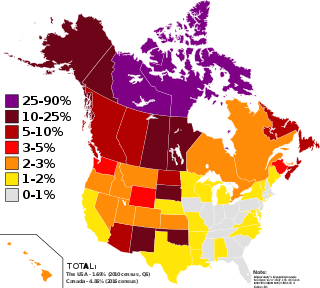
In Canada, Indigenous groups comprise the First Nations, Inuit, and Métis. Although Indian is a term still commonly used in legal documents, the descriptors Indian and Eskimo have fallen into disuse in Canada, and most consider them to be pejorative. Aboriginal peoples as a collective noun is a specific term of art used in some legal documents, including the Constitution Act, 1982, though in most Indigenous circles Aboriginal has also fallen into disfavour.

The legal system of Canada is pluralist: its foundations lie in the English common law system, the French civil law system, and Indigenous law systems developed by the various Indigenous Nations.
First Nations is a term used to identify those Indigenous Canadian peoples who are neither Inuit nor Métis. Traditionally, First Nations in Canada were peoples who lived south of the tree line, and mainly south of the Arctic Circle. There are 634 recognized First Nations governments or bands across Canada. Roughly half are located in the provinces of Ontario and British Columbia.
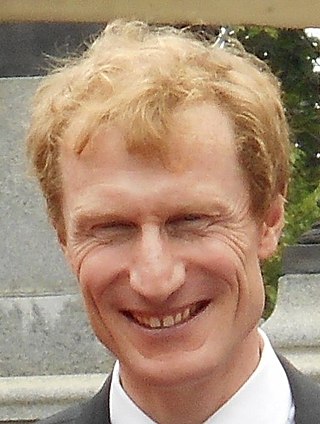
The minister of Crown–Indigenous relations is a minister of the Crown in the Canadian Cabinet, one of two ministers who administer Crown-Indigenous Relations and Northern Affairs Canada (CIRNAC), the department of the Government of Canada which is responsible for administering the Indian Act and other legislation dealing with "Indians and lands reserved for the Indians" under subsection 91(24) of the Constitution Act, 1867. The minister is also more broadly responsible for overall relations between the federal government and First Nations, Métis, and Inuit.

The Assembly of First Nations (AFN) is an assembly of Canadian First Nations represented by their chiefs. Established in 1982 and modelled on the United Nations General Assembly, it emerged from the National Indian Brotherhood, which dissolved in the late 1970s.
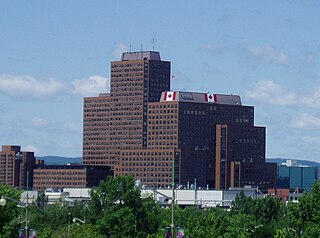
Crown–Indigenous Relations and Northern Affairs Canada is the department of the Government of Canada responsible for Canada's northern lands and territories, and one of two departments with responsibility for policies relating to Indigenous peoples in Canada.
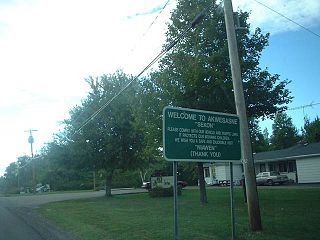
The Mohawk Nation at Akwesasne is a Mohawk Nation (Kanienʼkehá:ka) territory that straddles the intersection of international borders and provincial boundaries on both banks of the St. Lawrence River. Although divided by an international border, the residents consider themselves to be one community. They maintain separate police forces due to jurisdictional issues and national laws.
George Manuel, OC was an Aboriginal leader in Canada. Born and raised in British Columbia, he became politically active there and in Alberta. In 1970 he was elected and served until 1976 as chief of the National Indian Brotherhood. In 1975 he founded and became president of the World Council of Indigenous Peoples, serving until 1981.
In Canada, an Indian band or band, sometimes referred to as a First Nation band or simply a First Nation, is the basic unit of government for those peoples subject to the Indian Act. Bands are typically small groups of people: the largest in the country, the Six Nations of the Grand River First Nation had 22,294 members in September 2005, and many have a membership below 100 people. Each First Nation is typically represented by a band council chaired by an elected chief, and sometimes also a hereditary chief. As of 2013, there were 614 bands in Canada. Membership in a band is controlled in one of two ways: for most bands, membership is obtained by becoming listed on the Indian Register maintained by the government. As of 2013, there were 253 First Nations which had their own membership criteria, so that not all status Indians are members of a band.

Canadian Aboriginal law is the body of law of Canada that concerns a variety of issues related to Indigenous peoples in Canada. Canadian Aboriginal Law is different from Canadian Indigenous law: In Canada, Indigenous Law refers to the legal traditions, customs, and practices of Indigenous peoples and groups. Aboriginal peoples as a collective noun is a specific term of art used in legal documents, including the Constitution Act, 1982, and includes First Nations, Inuit and Métis people. Canadian Aboriginal law provides certain constitutionally recognized rights to land and traditional practices. Canadian Aboriginal Law enforces and interprets certain treaties between the Crown and Indigenous people, and manages much of their interaction. A major area of Aboriginal law involves the duty to consult and accommodate.
The association between the Canadian Crown and Indigenous peoples in Canada stretches back to the first decisions between North American Indigenous peoples and European colonialists and, over centuries of interface, treaties were established concerning the monarch and Indigenous nations. First Nations, Inuit, and Métis peoples in Canada have a unique relationship with the reigning monarch and, like the Māori and the Treaty of Waitangi in New Zealand, generally view the affiliation as being not between them and the ever-changing Cabinet, but instead with the continuous Crown of Canada, as embodied in the reigning sovereign. These agreements with the Crown are administered by Canadian Aboriginal law and overseen by the Minister of Indigenous and Northern Affairs.

The Act to Encourage the Gradual Civilization of Indian Tribes in this Province, and to Amend the Laws Relating to Indians was a bill passed by the 5th Parliament of the Province of Canada in 1857. The Act established a voluntary process through which any recognized male Indian could apply to become "enfranchised", wherein they would lose their legal ‘Indian status’ and become a regular British subject. Applications were open to those fluent in English or French, with approval subject to assessment by a committee of non-Indigenous reviewers. Enfranchised Indians would be granted an allotment of land and the ability to vote.
The Canadian Indian Health Transfer Policy provides a framework for the assumption of control of health services by Indigenous peoples in Canada and set forth a developmental approach to transfer centred on the concept of self-determination in health. Through this process, the decision to enter into transfer discussions with Health Canada rests with each community. Once involved in transfer, communities are able to take control of health program responsibilities at a pace determined by their individual circumstances and health management capabilities.

Pimicikamak is an indigenous people in Canada. Pimicikamak is related to, but constitutionally, legally, historically and administratively distinct from, the Cross Lake First Nation which is a statutory creation that provides services on behalf of the Canadian Government. Pimicikamak government is based on self-determination and has a unique form.
The Anishinaabe Nation in Treaty No. 3 is a sovereign Anishinaabe Nation in Canada. It has existed as a self-governing people with its own laws and government institutions since time immemorial, before the arrival of European settlers. "America, separated from Europe by a wide ocean, was inhabited by ... separate nations, independent of each other and of the rest of the world, having institutions of their own, and governing themselves by their own laws." "The territory included in Treaty #3 in 1873 was governed by a Grand Council of Anishinaabe Chiefs. ... This civil leadership was responding to other political ranks and ultimately to the constituent families." The Nation is, by constitutional definition, the Anishinaabe people that entered into Treaty 3 with the Crown in 1873.
The following is an alphabetical list of topics related to Indigenous peoples in Canada, comprising the First Nations, Inuit and Métis peoples.
Arthur Manuel was a First Nations political leader in Canada. The son of Marceline Paul of the Ktunaxa Nation and political leader George Manuel of the Secwepemc Nation, he grew up on the Neskonlith Reserve in the interior of British Columbia. He attended the Kamloops, St Eugene's and St. Mary's residential schools, Concordia University and Osgoode Hall Law School. He was the father of five children.
Indigenous or Aboriginal self-government refers to proposals to give governments representing the Indigenous peoples in Canada greater powers of government. These proposals range from giving Aboriginal governments powers similar to that of local governments in Canada to demands that Indigenous governments be recognized as sovereign, and capable of "nation-to-nation" negotiations as legal equals to the Crown, as well as many other variations.
Leroy Little Bear is a Blackfoot researcher, professor emeritus at the University of Lethbridge, founding member of Canada's first Native American Studies Department, and recognized leader and advocate for First Nations education, rights, self-governance, language and culture. He has received numerous awards and recognition for his work, including the Officer Order of Canada, and the Alberta Order of Excellence.
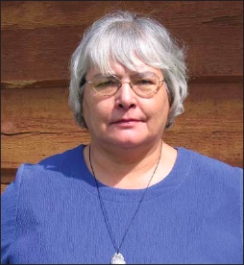
Marie Smallface Marule was a Canadian academic administrator, activist, and educator. She served as executive director of the National Indian Brotherhood (NIB), chief administrator of the World Council of Indigenous Peoples (WCIP), and secretary of the Indian Association of Alberta. Marule was president of Red Crow Community College for two decades, and led the creation of several indigenous studies programs. She was previously an assistant professor of Native American studies at the University of Lethbridge.
References
- ↑ George-Kanentiio, D. (February 2011). "Ernest Kaientaronkwen Benedict: (1918-2011) Akwesasne's Conscience". Indian Country News. Retrieved 2019-07-07.
- ↑ "Michael Posluns fonds (F0382)". 2003-05-06. Retrieved 2017-04-18.
- ↑ Posluns, Michael Wilfred (2013-08-30). "The Allocation of Burdens in Litigation Between First Nations and the Crown".
{{cite journal}}: Cite journal requires|journal=(help) - ↑ Alia, Valerie (2013-07-15). The New Media Nation: Indigenous Peoples and Global Communication. Berghahn Books. ISBN 9780857454096.
- ↑ Posluns, Michael W. (2006-10-27). Speaking with Authority: The Emergence of the Vocabulary of First Nations' Self-Government. Routledge. ISBN 9781135940393.
- 1 2 Posluns, Michael (2013-01-15). "First nation myths remain woven into the Canadian fabric". The Globe and Mail. Retrieved 2017-04-18.
- ↑ "Benjamin's Park Memorial Chapel - Service Details". www.benjaminsparkmemorialchapel.ca. Retrieved 2020-01-12.